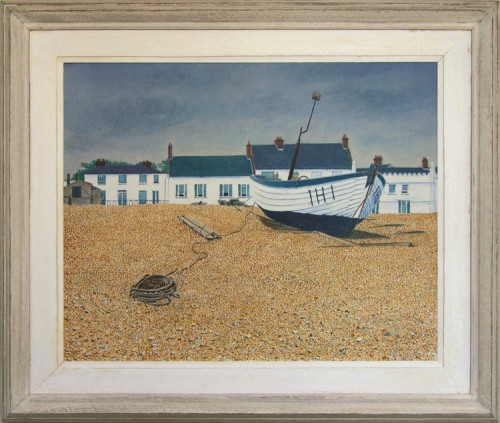Oppenheim’s landscapes are more representational than either the schematic but very expressive civil defence scenes painted in London during the war, or his abstracted and stylized still life paintings. He seems to have painted wherever he found himself – in Florence, Lucca, Provence, or here, in Aldeburgh; and – whilst the perspective of his landscapes is always illusionistically convincing in its depth – he uses tricks taken from the decorative patterning of his other work to create texture and shadow. Here, the great bank of shingly Suffolk beach is reproduced by pointilliste dots on a sand-coloured ground, with a few larger taches indicating nearer stones. Close to the effect is completely flat, the realistically-drawn rope, planks and boat floating free of their background; at a distance, however, the boat settles onto the shingle with a sigh of complete realism, cast shadows emphasizing the recession of space over a suddenly wide and illusionistic beach. This is a painting which uses very simple effects to depict a fiercely localized scene: the whitewashed Georgian cottages, slice of a vast grey sky, boat and pebbles are intensely redolent of the Suffolk coast.
Biographical details
Sir Duncan Morris Oppenheim was born in St Helen’s, Lancashire, and educated at Repton. He first exhibited his watercolours in the Walker Art Gallery, Liverpool, at the age of 19, but rather than pursue a career in art he entered the family firm of solicitors. He joined British American Tobacco as a solicitor in 1934, and rose to become chairman from 1953-66; he also played a prominent part in the CBI, became a director of Lloyds Bank and chairman of the Tobacco Securities Trust, amongst other posts. During the Second World War he served part-time in the Home Guard in Westminster, whilst continuing to work for British American Tobacco and painting images of civil defence in London.
He continued to paint, becoming a skilful artist in both watercolour and acrylics; he exhibited with the London Group (1954), and in the Royal Academy from 1957-84. In the 1970s he had a one-man show at the Upper Grosvenor Galleries, the catalogue for which had an introduction by Carel Weight, who compared Oppenheim’s work to that of Odilon Redon. Two-thirds of the paintings were subsequently sold. He had further one-man shows at Spink & Sons (1980-83) and New Grafton Gallery (1985 onward).
Oppenheim advised Sir David Eccles, Minister for Works, on the art displayed in ministries and British embassies, and became chairman of the council of the Royal College of Art, receiving an honorary doctorate in 1972. Whilst at the College he encountered both Stanley Spencer and David Hockney, the latter with hair dyed gold and wearing gold lamé to receive a gold medal from Sir Duncan. He also served as chairman of the Council of Industrial Design (1960-72); committee member for the V & A (1967-79); and deputy chairman of the Arts Council (1972-83). In 1960 he was knighted, and in 1969 was awarded the bicentenary medal of the Royal Society of Arts.
Works in public collections include Boredom: air raid wardens on duty, 1940; Finding an unexploded bomb, Barton Street, London SW1, 1940; Searching for casualties…, 1940; The terrible boredom of waiting for action, 1940; The loneliness of an air raid warden on patrol…, 1940-41 (all London, Imperial War Museum).
See obituary, 11 January 2003, Daily Telegraph.


